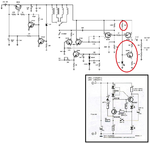neazoi
Advanced Member level 6
Hello,
The oscillator design attached uses a simple bc547 and a LED (red circles) as a contant current source for the buffer amplifier FET (am I right?)
Could I use the constant current source circuit shown inside the square to replace the current source? The circuit is described here **broken link removed**
How should I connect this to the FET?
Or should I use a more straight forward circuit like this **broken link removed**
The oscillator design attached uses a simple bc547 and a LED (red circles) as a contant current source for the buffer amplifier FET (am I right?)
Could I use the constant current source circuit shown inside the square to replace the current source? The circuit is described here **broken link removed**
How should I connect this to the FET?
Or should I use a more straight forward circuit like this **broken link removed**
